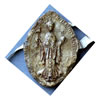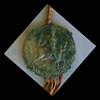Medieval Seals
KINGS AND QUEENS
Please click on the pictures to display a larger image.
Duncan II king of Scots, 1093 or 1094, G&B 3073. The oldest seal of the kings of Scots, known only from this example. It is also one of the oldest in the Cathedral Muniments. It was probably attached to a blank sheet of parchment: the scribe wrote the text on the opposite side from that intended, and the text was not nearly long enough to fill up the entire space. The document is discussed in A. A. M. Duncan, `The earliest Scottish charters', Scottish Historical Review 37 (1958), 103-35, and `Yes, the earliest Scottish charters', Ibid. 78 (1999), 1-38. The seal differs from that of the English king in being only one-sided, as does that of Edgar king of Scots (1097-1107), although in his case he is shown enthroned holding sceptre and sword; with Alexander I (1107-24) the Scottish kings adopted the double-sided English model. MC 554 * |
|
William II king of the English (1087-1100), reverse, G&B 3013. MC 973 * |
|
Matilda queen of England (1100-18), G&B 3018. 1.2.Spec.23 * |
|
Henry III king of England, first great seal (1219-59), reverse, G&B 3025. 1.2.Reg.2 |
|
Edward I king of England (1272-1307), great seal, obverse, G&B 3027. 2.2.Reg.6. |
|
Edward I king of England, quarter great seal or pes sigilli. Used on a writ of ephemeral significance. 1.5.Ebor.12 * |
|
|
Henry IV king of England, great seal, G&B 3033. Identical with the Bretigny seal of Edward III and Richard II, with the name in the legends altered. 1.5.Reg.1 * |
|
Henry VIII King of England, sign manual. Loc.XXV:100 |







